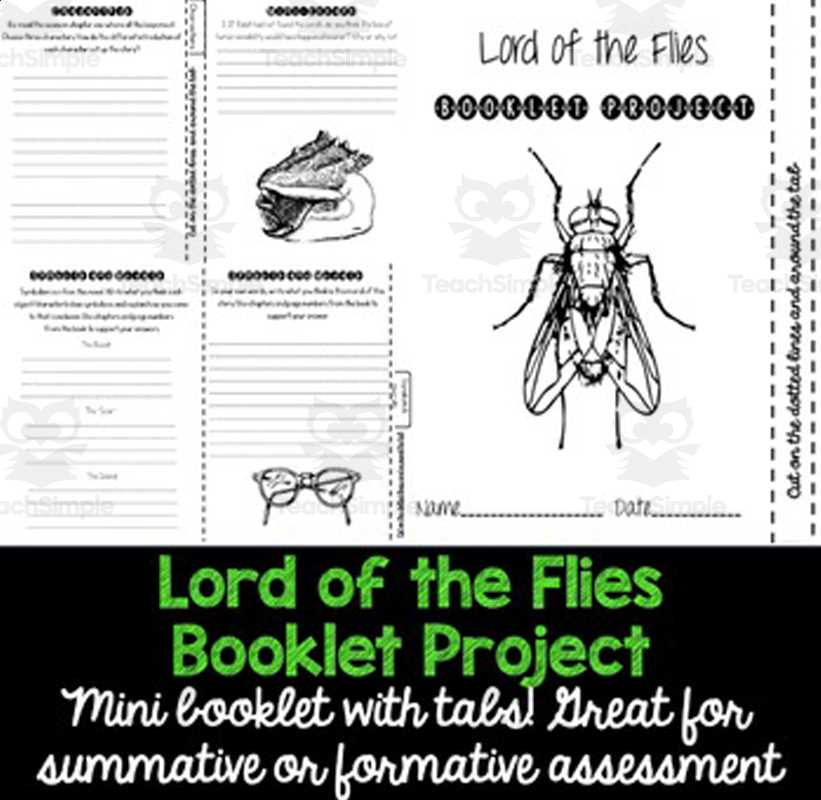
Understanding the complex dynamics of human nature and society is at the heart of this remarkable novel. Through vivid characters and a compelling narrative, the text reveals how individuals respond to isolation, power, and survival. By examining these elements closely, readers can gain valuable insights into the darker aspects of human behavior and societal structures.
Key ideas explored in this work address the tensions between civilization and chaos, the impact of fear on decision-making, and the profound struggle for dominance. These themes are woven throughout the story, offering readers a chance to reflect on how they relate to our own world. The author skillfully uses symbolism and character development to illuminate these core issues.
Through a series of critical events and shifting alliances, the narrative unfolds in a way that challenges readers to think critically about the nature of leadership, morality, and power. The characters’ experiences serve as a mirror to the complexities of human behavior in extreme circumstances, making this work an enduring subject of study and discussion.
Study Guide for Lord of the Flies Answers
This section explores the central elements of the novel, offering insights and a deeper understanding of its themes, characters, and symbols. By analyzing key moments and their significance, readers can gain a clearer perspective on the underlying messages within the text. Understanding these components will help in comprehending the broader implications of the narrative.
Core Themes and Concepts
- Civilization vs. Savagery: The tension between order and chaos is a constant throughout the narrative, with the characters’ descent into primal instincts reflecting the fragility of societal structures.
- Fear and Its Influence: Fear drives many actions in the story, shaping the characters’ decisions and interactions, often leading to irrational behavior and conflict.
- Power and Leadership: The struggle for control and influence is central to the plot, with each character representing different approaches to authority and governance.
Character Breakdown
- Ralph: Represents order, leadership, and civility. His attempts to maintain structure on the island contrast sharply with the chaos around him.
- Jack: Embodies savagery and the desire for power. His rise to dominance highlights the dangers of unchecked ambition and the allure of anarchic freedom.
- Piggy: Symbolizes intellect and reason, though often overlooked and marginalized. His insights are crucial, yet his physical vulnerability makes him an outsider.
By focusing on these areas, readers can better grasp the complexities of the narrative and how the author uses each character and event to illustrate broader social and psychological themes.
Key Themes in Lord of the Flies
At the heart of the novel are profound explorations of human nature, survival instincts, and the complexities of social organization. These themes delve into how individuals and groups behave when removed from the constraints of society. The narrative emphasizes the contrast between order and chaos, highlighting the impact of fear, power struggles, and moral choices on the characters’ actions.
Conflict Between Civilization and Chaos
The tension between maintaining order and succumbing to anarchy is a central theme. As the boys attempt to govern themselves on the island, their varying responses to leadership and authority illustrate how fragile societal norms are when faced with the instinct to survive. This theme explores the fine line between civilization and savagery, where the desire for control often leads to the collapse of structure.
The Role of Fear in Decision Making
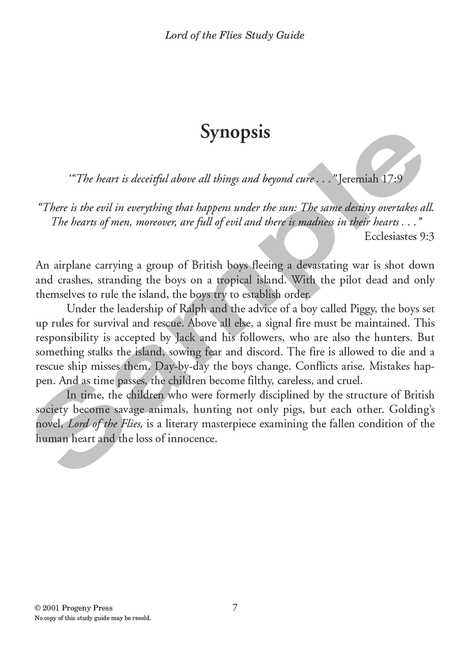
Fear plays a critical role throughout the story, influencing characters’ actions and fueling their descent into violence. The fear of the unknown, particularly the imaginary beast, becomes a powerful force that drives the boys to make irrational and destructive decisions. This theme explores how fear can manipulate individuals and lead to the erosion of reason, often causing harm to both oneself and others.
These themes reflect the darker aspects of human behavior and the consequences of abandoning moral and societal frameworks. Through the characters’ experiences, readers are prompted to consider how similar situations might unfold in the real world, offering a powerful commentary on the human condition.
Character Analysis of Ralph and Jack
The relationship between Ralph and Jack forms the foundation of the story’s exploration of leadership and power. Their contrasting personalities create a constant tension, with Ralph symbolizing order, responsibility, and civilization, while Jack embodies chaos, power, and primal instincts. As the narrative progresses, the dynamic between them becomes more complex, revealing the internal conflicts that arise when individuals are pushed beyond their limits.
| Trait | Ralph | Jack |
|---|---|---|
| Leadership Style | Democratic, focused on collaboration and rescue. | Autocratic, centered on fear and control. |
| Key Values | Order, rationality, and hope for survival. | Power, independence, and indulging in instincts. |
| Approach to Conflict | Prefers negotiation and peaceful resolutions. | Uses intimidation and violence to assert dominance. |
| Symbolism | Civilization, hope, and structured society. | Savagery, rebellion, and the breakdown of social order. |
Ralph’s leadership is characterized by his dedication to structure and the belief in collective action as a means of ensuring the group’s survival. He focuses on maintaining a signal fire, building shelters, and keeping the boys united with the shared goal of being rescued. Ralph’s authority is rooted in reason and mutual respect, though his position becomes increasingly fragile as the group fractures. On the other hand, Jack’s desire for control leads him to abandon the rules that Ralph upholds, opting instead for violence and fear to dominate the group. His obsession with hunting and his rejection of order highlight his descent into savagery, which becomes more pronounced as the story progresses.
The conflict between Ralph and Jack reflects a larger theme of civilization versus chaos. Ralph’s attempts to preserve societal norms are in constant opposition to Jack’s embrace of power and freedom from constraints. As their rivalry intensifies, it becomes clear that both characters embody fundamental aspects of human nature–one striving for peace and structure, the other for domination and primal release. Their actions and choices ultimately reveal how fragile order can be when confronted with human instincts driven by fear, power, and survival.
Symbolism of the Conch Shell
The conch shell in the narrative serves as a powerful symbol of authority, order, and civilization. Initially discovered by the boys, it becomes a tool for establishing communication and structure within their makeshift society. As the story unfolds, the conch’s significance evolves, reflecting the gradual breakdown of the boys’ society and their descent into chaos. What begins as a representation of democratic leadership and unity transforms into a fragile object that ultimately loses its power in the face of increasing disorder.
| Symbol | Meaning at the Start | Meaning at the End |
|---|---|---|
| Conch Shell | Represents authority, law, and the right to speak. | Symbolizes the collapse of order and the breakdown of society. |
| Sound of the Conch | Calls the group together, ensuring a sense of unity and structure. | Becomes ineffective, ignored as chaos takes hold. |
| Physical State | Intact, vibrant, and respected by all. | Broken and disregarded, losing its influence. |
| Connection to Civilization | A tool that upholds the boys’ connection to structured society. | Its destruction mirrors the collapse of social order among the boys. |
In the early stages of the narrative, the conch shell is integral to maintaining order within the group. It grants the right to speak during meetings and is respected by all, symbolizing the boys’ initial adherence to rules and their desire to preserve a civilized way of life. The sound of the conch gathers the boys, uniting them in their shared purpose and bringing a semblance of structure to their otherwise chaotic situation. However, as the tension between Ralph and Jack grows and the boys’ behavior becomes more unruly, the conch’s authority begins to fade.
The breaking of the conch marks a pivotal moment in the story, symbolizing the complete collapse of the fragile society the boys have tried to build. Its destruction signals the end of reasoned discourse and the triumph of brute force and primal instincts, as represented by Jack and his followers. The loss of respect for the conch highlights the disintegration of civilized values, reflecting the dark side of human nature when removed from the constraints of society. Ultimately, the conch serves as a poignant reminder of how easily order can be overthrown when confronted by chaos and unchecked power.
The Role of Piggy in the Story
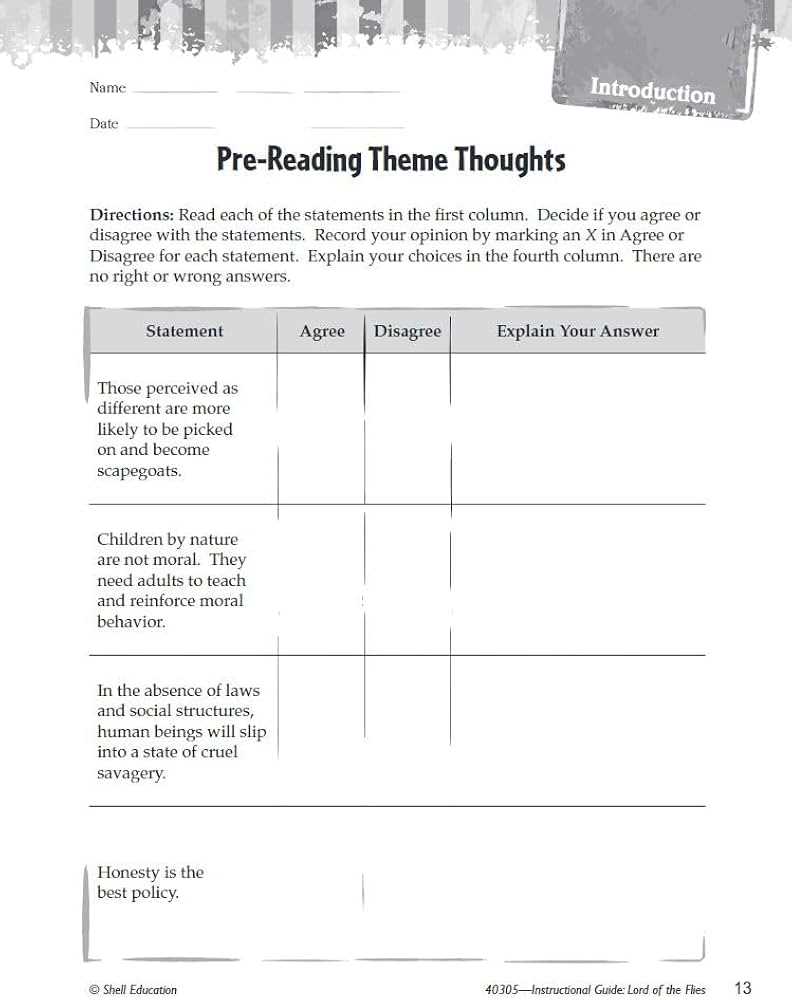
Piggy plays a crucial role in highlighting the themes of intellect, reason, and the struggle for survival within the narrative. As an outsider due to his physical appearance and perceived weaknesses, Piggy often serves as the voice of logic and rationality among the boys. However, his ideas and contributions are frequently dismissed or ignored, which reflects the tension between civilization and savagery. Throughout the story, Piggy’s character exemplifies the fragile nature of intellectualism and the importance of voice in a society prone to chaos and power struggles.
Intellectual Leadership
Piggy, despite his physical limitations and social alienation, offers insightful solutions to the group’s challenges. His intelligence and ability to think critically make him a key figure in the attempt to maintain order. While Ralph tries to lead through democratic principles, Piggy’s ideas often serve as the foundation for survival strategies, such as using the conch to organize meetings and keeping the fire burning as a signal for rescue. Piggy’s focus on logic and planning stands in stark contrast to the emotional and primal responses exhibited by other boys, particularly Jack.
Social Isolation and Struggles
Despite his intellectual contributions, Piggy is consistently marginalized by the group. His physical appearance, asthmatic condition, and lack of social status make him an easy target for bullying, especially by Jack and his followers. This exclusion highlights the difficulty of maintaining civility in an environment where strength and dominance are valued over reason. Piggy’s character arc underscores the theme of intellectualism being vulnerable in the face of brute force and social conformity. His death, at the hands of the very chaos he tried to prevent, marks a tragic end to the rational voice he represents.
Understanding the Beast in the Novel
The “beast” in the story serves as a complex symbol representing the primal fears, internal darkness, and inherent savagery within each individual. While the boys initially believe in a tangible, physical creature lurking on the island, the real “beast” is much more abstract. It embodies the descent into chaos and the loss of civilized behavior, highlighting the boys’ struggle between maintaining order and surrendering to their darker impulses. The fear of the beast grows as the boys’ personalities and priorities evolve, becoming a central force in the story’s progression.
The External Beast: Fear of the Unknown
Initially, the beast is described in terms of a mysterious creature lurking within the jungle. The boys, especially the younger ones, become terrified by the idea of something lurking in the shadows. This fear is amplified by the isolation of the island, where the unknown becomes a powerful threat. The external beast represents how fear of the unknown can shape actions and decisions, even in the most rational individuals. This externalization of fear drives much of the boys’ actions, leading them to form groups and engage in violent behaviors as they attempt to protect themselves from an unseen enemy.
The Internal Beast: Human Nature Revealed
As the story progresses, it becomes clear that the real beast is not an external creature but something much more dangerous–human nature itself. As the boys’ behavior deteriorates, their descent into savagery highlights the internal “beast” that resides within each of them. Fear, power struggles, and primal instincts take over as civilization’s influence fades. The character of Jack, in particular, embodies the unleashing of this inner darkness, as he becomes consumed with control and violence. Ultimately, the beast is not something that can be hunted or killed but a force that resides within the boys, shaping their actions and their society.
- The external beast reflects the fear of the unknown, driving the boys to act irrationally.
- The internal beast represents the darker side of human nature, revealed through fear and violence.
- The idea of the beast challenges the notion of civilization, showing how fragile societal norms can be.
The Significance of the Island Setting
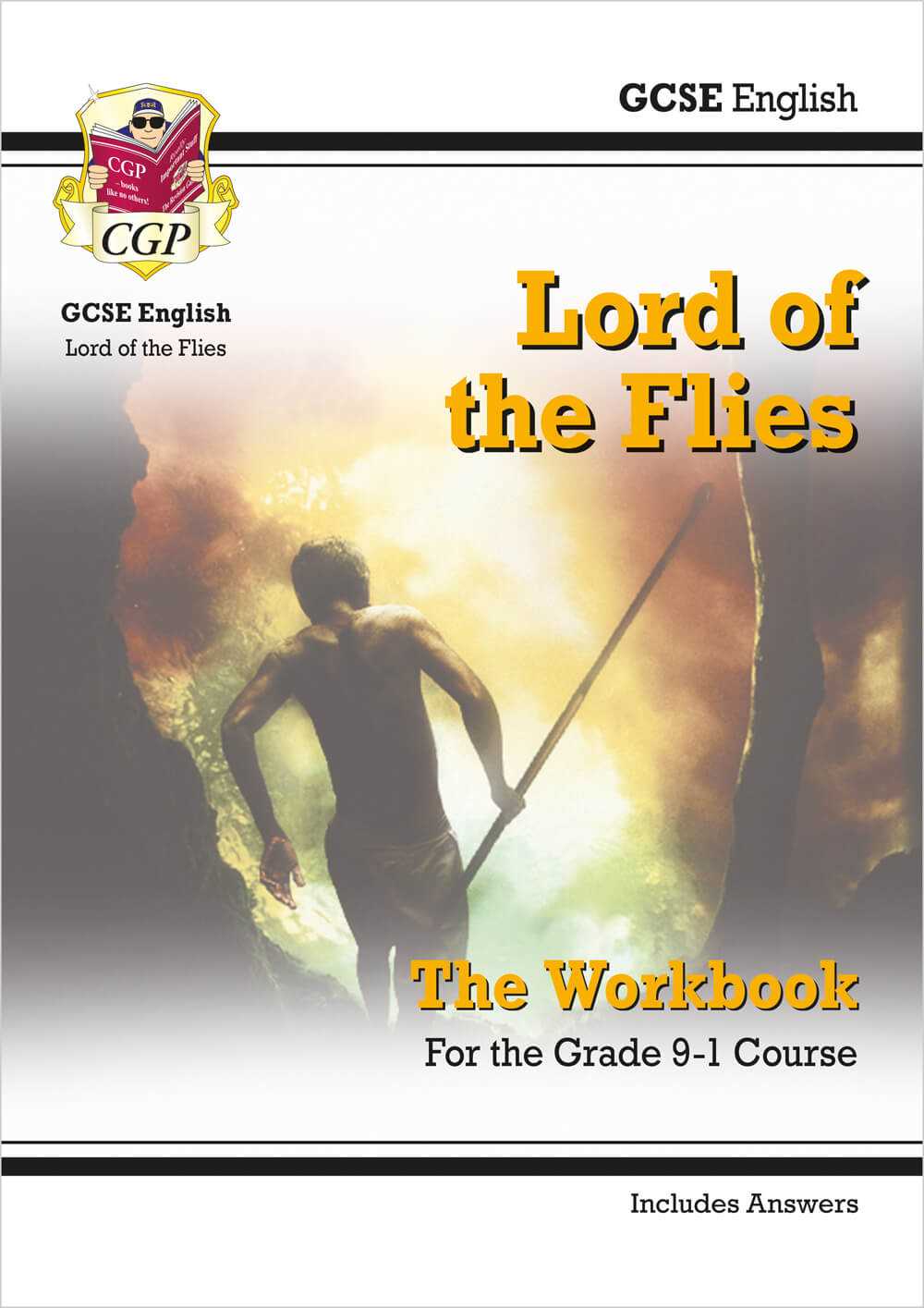
The island in the story serves as both a physical and symbolic space, reflecting the themes of isolation, civilization versus savagery, and the inherent nature of humanity. Its remote location separates the boys from society, forcing them to create their own rules and structure. The setting allows for an exploration of how humans behave when removed from the constraints of civilization, offering insights into the darker aspects of human nature. As the boys’ situation deteriorates, the island itself transforms from a paradise to a prison, mirroring the boys’ descent into chaos.
Isolation and Self-Sufficiency
The isolation of the island is crucial in the development of the plot. Without any adults or authority figures, the boys are left to govern themselves. This isolation creates a sense of freedom at first, but it soon becomes clear that without societal structures, chaos can emerge. The boys are forced to rely on their own instincts and abilities to survive, which brings both cooperation and conflict. The island setting highlights how the absence of external control leads to a struggle for dominance and the breakdown of social order.
Symbolism of the Island’s Landscape
- The Beach: The beach represents civilization and order. It is where meetings are held and rules are established. As the boys’ behavior grows more erratic, the beach becomes less significant.
- The Jungle: The jungle symbolizes the wild and untamed aspects of nature. It becomes a place where fear and violence take root, mirroring the boys’ descent into savagery.
- The Mountain: The mountain offers a higher perspective and represents hope for rescue. However, it also becomes a site of conflict and tension as the boys’ priorities shift from survival to power struggles.
From Paradise to Prison
Initially, the island appears to be an idyllic paradise, with its clear waters and abundant resources. However, as the boys’ behavior becomes more brutal, the island shifts from a haven to a symbol of entrapment. The isolation that once offered freedom becomes a prison, trapping the boys in their own fears and conflicts. The setting underscores the idea that without societal structures and moral guidance, even the most beautiful places can become sites of violence and destruction.
Conflict Between Civilization and Savagery
The struggle between order and chaos is a central theme in the narrative, illustrating the tension between maintaining societal norms and embracing primal instincts. As the boys are isolated on the island, they are forced to choose between establishing a structured society or surrendering to their more savage tendencies. This conflict serves as a powerful commentary on human nature, highlighting how easily civilization can unravel when individuals are pushed beyond their familiar environment. The story examines the fine line between civility and barbarism, showing that beneath the veneer of order lies a deep-seated capacity for violence and disorder.
The Role of Ralph: The Symbol of Order
Ralph represents the ideals of civilization, law, and order. From the outset, he strives to create a structured society where decisions are made through assemblies and everyone works together to ensure survival. His focus on building shelters and maintaining the signal fire reflects his belief in hope and rescue, which can only be achieved through cooperation and discipline. However, as the challenges of survival grow, Ralph’s authority begins to weaken, and his efforts to uphold these values become increasingly difficult. His internal conflict symbolizes the fragility of civilization in the face of human nature’s darker impulses.
The Role of Jack: The Symbol of Savagery
Jack, in stark contrast to Ralph, represents the allure of savagery, freedom from rules, and the quest for power. Initially, Jack is introduced as a leader of the choirboys, a group that holds some semblance of order. However, as the boys face the harsh realities of survival, Jack gradually sheds the constraints of civilization and embraces violence and fear as a means of control. His desire for power grows as he manipulates the other boys, offering them freedom from the rules in exchange for loyalty. His descent into savagery is a clear representation of the darker side of human nature, showing how easily one can abandon societal values in the pursuit of dominance.
| Character | Symbolism | Key Actions |
|---|---|---|
| Ralph | Order, Civilization, Hope | Building shelters, maintaining the signal fire, striving for unity |
| Jack | Savagery, Power, Anarchy | Hunting, leading a rebellion, fostering fear and violence |
Ultimately, the conflict between Ralph and Jack highlights the fundamental clash between the forces of order and chaos. As the story unfolds, it becomes clear that while civilization may offer structure and hope, it is constantly at risk of being overrun by the primal urges that lie dormant within all individuals. The island, isolated from the influences of the outside world, acts as a microcosm for this eternal struggle.
The Impact of Power Struggles
Throughout the narrative, the battle for leadership plays a significant role in shaping the dynamics of the group. As different individuals vie for control, their actions and decisions create a ripple effect that influences the group’s structure and survival. This struggle for dominance not only affects the immediate relationships among the boys but also contributes to the eventual breakdown of order. The power struggles illustrate how authority and control can be wielded both for unity and division, highlighting the consequences of unchecked ambition and the human desire for power.
Ralph’s Struggle for Authority
Ralph’s leadership is initially grounded in his commitment to maintaining order and focusing on survival. However, as time passes, his authority is challenged by Jack and his growing following. Ralph’s difficulty in holding onto his leadership is a reflection of the vulnerability of democratic systems in the face of competing interests. Despite his best efforts to keep the boys unified and focused on common goals, his authority is slowly eroded, leading to internal conflict and division within the group. This struggle underscores the fragility of structured leadership in a lawless environment.
Jack’s Rise to Power
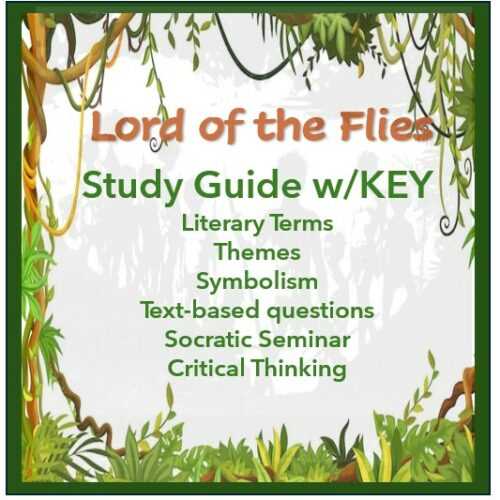
Jack’s thirst for power is a central force in the narrative. Initially, his role as the leader of the choirboys suggests a sense of order and discipline. However, as he becomes increasingly obsessed with hunting and rejecting Ralph’s leadership, Jack exploits fear and violence to manipulate the group. He gradually establishes a rival faction based on brutality and the promise of freedom from rules. His rise to power marks a shift from cooperation to chaos, as he uses the boys’ primal instincts to assert control and consolidate his leadership. The impact of Jack’s quest for power ultimately leads to the disintegration of the group’s unity and the loss of innocence.
- Ralph attempts to maintain order through assemblies and cooperation.
- Jack manipulates fear and violence to gain followers and assert dominance.
- The power struggle between Ralph and Jack deepens divisions within the group.
- The boys’ conflicting desires for leadership result in the collapse of civility.
In the end, the impact of power struggles reveals the fragile nature of human cooperation in extreme conditions. The desire for control can easily lead to conflict, undermining unity and exposing the darker aspects of human behavior.
The Role of the Choirboys in the Plot
The choirboys serve a crucial function in the narrative, acting as both a symbol of innocence and a group that shifts between order and chaos. Initially, they represent a semblance of discipline and structure, as they are introduced under Jack’s leadership. However, as the plot unfolds, their transition from a disciplined group to one marked by violence and savagery highlights the impact of the surrounding environment and the influence of power struggles. Their role evolves as they become key players in the conflict, playing a significant part in the disintegration of societal norms among the boys.
At the beginning of the story, the choirboys are presented as a well-organized group, aligned with Jack’s command. Their initial portrayal reflects a sense of order, which is central to their identity. However, as tensions rise and power struggles intensify, they begin to lose their connection to civilization and embrace more primal instincts. This shift illustrates how external pressures, such as the breakdown of structured leadership, can lead to the unraveling of civility within individuals.
Throughout the story, the choirboys transition from being followers of a leader to independent agents of chaos. Their role in the plot emphasizes the fragility of societal order and the ease with which individuals, particularly when grouped together, can succumb to darker impulses. Their involvement in key events, such as the hunts and ultimately the tragic death of Piggy, demonstrates the extent to which their character arc reflects the overarching themes of violence, power, and loss of innocence.
The Boys’ Journey into Darkness
As the narrative unfolds, the boys undergo a gradual but chilling transformation, descending from innocence to savagery. What begins as a seemingly innocent adventure quickly spirals into a descent into chaos, fueled by fear, power struggles, and the breakdown of societal norms. Their journey into darkness is marked by the loss of their moral compass and the rise of primal instincts that dominate their behavior. This transformation reflects the inherent conflict between civilization and barbarism, showing how easily individuals can succumb to darker forces when removed from the structure of society.
The Initial Spark of Savagery
At first, the boys try to establish order and structure through leadership and rules. However, their attempts at maintaining civility are quickly undermined by fear and the emerging desire for power. As fear of an unseen “beast” grows, their sense of unity fractures, and the need for survival begins to outweigh the ideals of cooperation and teamwork. This shift marks the first step in their journey into darkness, where their actions start to reflect a deeper, more primal nature.
The Climax of Violence
The turning point in their descent occurs during the tragic events that lead to the deaths of Simon and Piggy. The boys, once innocent and orderly, are now capable of horrific violence. This violence is not just a result of external threats, but an expression of their internal fears and desires for power. As they embrace savagery, they become disconnected from their previous identities and lose their humanity, illustrating the novel’s central theme: when social structures collapse, humanity’s darker impulses take over.
Through this progression, the novel examines how easily individuals, particularly in a group, can be influenced by fear, power, and chaos, ultimately leading to the complete breakdown of morality and order. The boys’ journey into darkness is not just physical but psychological, as they slowly shed their civilized selves to reveal the raw, untamed aspects of their personalities.
The Symbolism of the Lord of the Flies
In the narrative, an object of profound symbolism is introduced–a severed pig’s head mounted on a stick. Initially, it may appear to be just an eerie and grotesque artifact, but its significance extends much deeper. This symbol becomes a powerful representation of the darkness within the boys and the descent into savagery. The head, surrounded by flies, is not merely an offering to an imagined creature but a manifestation of the boys’ inner fears, chaos, and the breakdown of societal norms. It stands as a potent image of evil, corruption, and the ultimate destruction of innocence.
Manifestation of Evil
The severed head serves as a tangible representation of the evil that lurks within each of the boys. It is a visual manifestation of their collective descent into violence and brutality. The head, referred to as the “Lord of the Flies,” symbolizes the decay of civilization and the triumph of primal instincts. It acts as a force that pushes the boys further into madness, illustrating how, once freed from the restraints of society, human nature can become corrupt and consumed by chaos. The flies that swarm around it are symbolic of decay, filth, and corruption, reinforcing the idea that evil is spreading rapidly, consuming everything it touches.
Psychological and Philosophical Significance
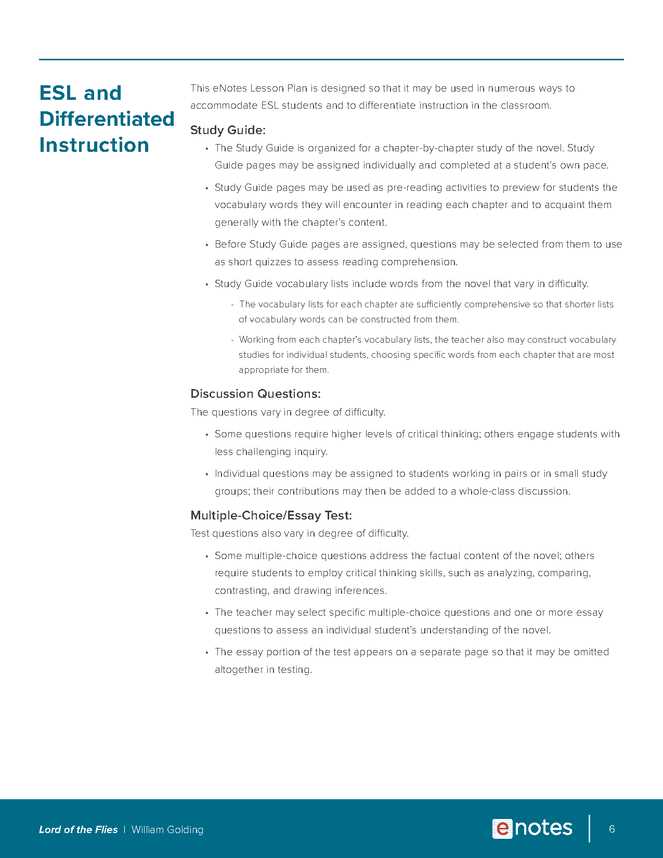
On a psychological level, the head represents the boys’ internal struggle with their own baser instincts. It’s not just a symbol of external forces, but also the darker aspects of human nature that each individual must grapple with. In this sense, the “Lord of the Flies” becomes a mirror for the characters, especially Simon, who realizes that the beast they fear is not some external force, but rather the evil within themselves. This realization, though tragic, highlights the central philosophical theme of the novel–that true evil is not an external force, but a reflection of mankind’s inherent flaws and weaknesses.
Ultimately, this symbol serves as a chilling reminder of the thin veneer of civilization and the ease with which it can be shattered. It illustrates how, in the absence of societal structures, chaos, violence, and evil can quickly dominate and consume humanity.
Comparing the Novel’s Ending to Its Beginning
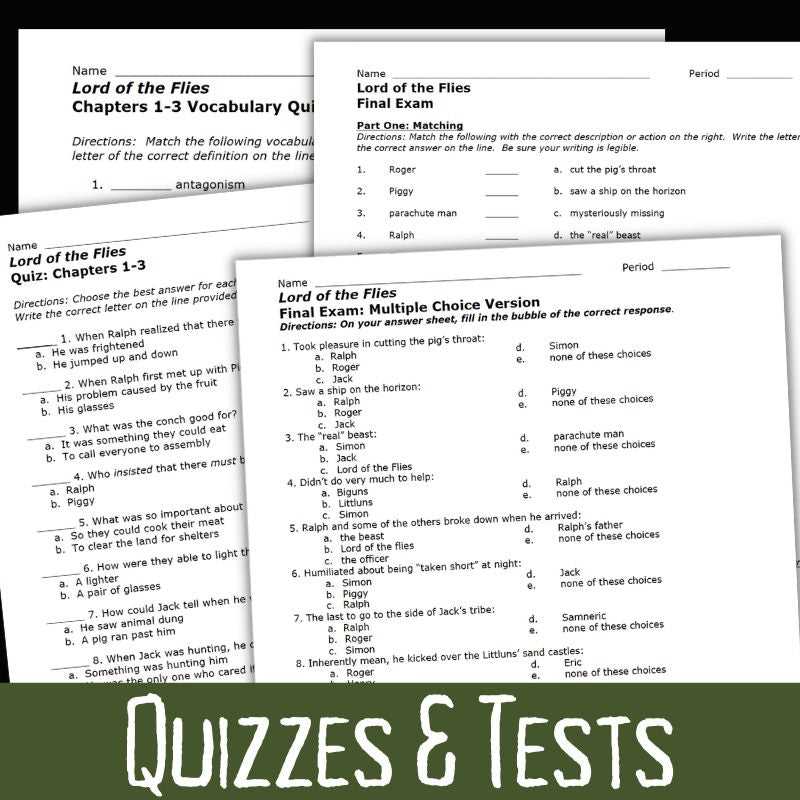
The journey of the characters in this tale begins with hope and excitement but gradually shifts to a descent into chaos and destruction. At the start, the boys are presented with the opportunity to create a society based on their own rules, free from adult supervision. They initially attempt to build order, but by the conclusion, the island is filled with violence and disorder, revealing the stark contrast between the opening and final moments. The narrative illustrates how the boys’ transformation reflects the broader themes of human nature and societal collapse.
Starting with Hope
At the novel’s outset, the group of boys are stranded on a remote island, seemingly optimistic about their situation. Some of their early actions highlight this sense of hope:
- Attempt to create a government and set rules for a peaceful society.
- Building shelters and making plans for survival.
- Using the conch as a symbol of authority and order.
There is a collective belief that structure and organization will guide them. They hold meetings, vote for leadership, and try to establish a functional community, all in the hopes of maintaining civility while waiting to be rescued. This phase represents a time of idealism, where the boys believe they can maintain control of their fate.
Descending into Chaos
By the end, the situation has drastically shifted. The once hopeful and organized group of boys becomes engulfed in violence, driven by fear and primal instincts. The final events reveal the true nature of the boys’ inner conflicts:
- Breakdown of order as Jack’s tribe rejects the rules of civilization.
- Violence erupts, culminating in the deaths of Simon and Piggy.
- The conch, once a powerful symbol of authority, is shattered, symbolizing the destruction of order.
The boys are no longer a cohesive group with shared goals; instead, they have divided into factions that embrace savagery. The final arrival of a naval officer, who is shocked by the disarray, serves as a grim reminder of the contrast between their original potential for unity and their eventual collapse into barbarism.
This dramatic shift from hope to despair underscores the novel’s central themes of civilization versus savagery, the loss of innocence, and the inherent darkness within humanity. What begins as an attempt to build a new society ends in tragedy, leaving readers to reflect on the fragility of order and the power of fear and instinct to disrupt it.
The Influence of Fear on Decisions
Throughout the narrative, fear plays a central role in shaping the actions and choices of the characters. It serves as both a motivator and a disruptor, leading individuals to make decisions that reflect their inner anxieties rather than rational thinking. As fear intensifies, it drives certain characters to abandon reason, contributing to the breakdown of order and the rise of chaos. The fear of the unknown, the fear of what lurks in the darkness, and the fear of losing control all influence the boys’ behavior and ultimately determine their fate.
Fear of the Unknown
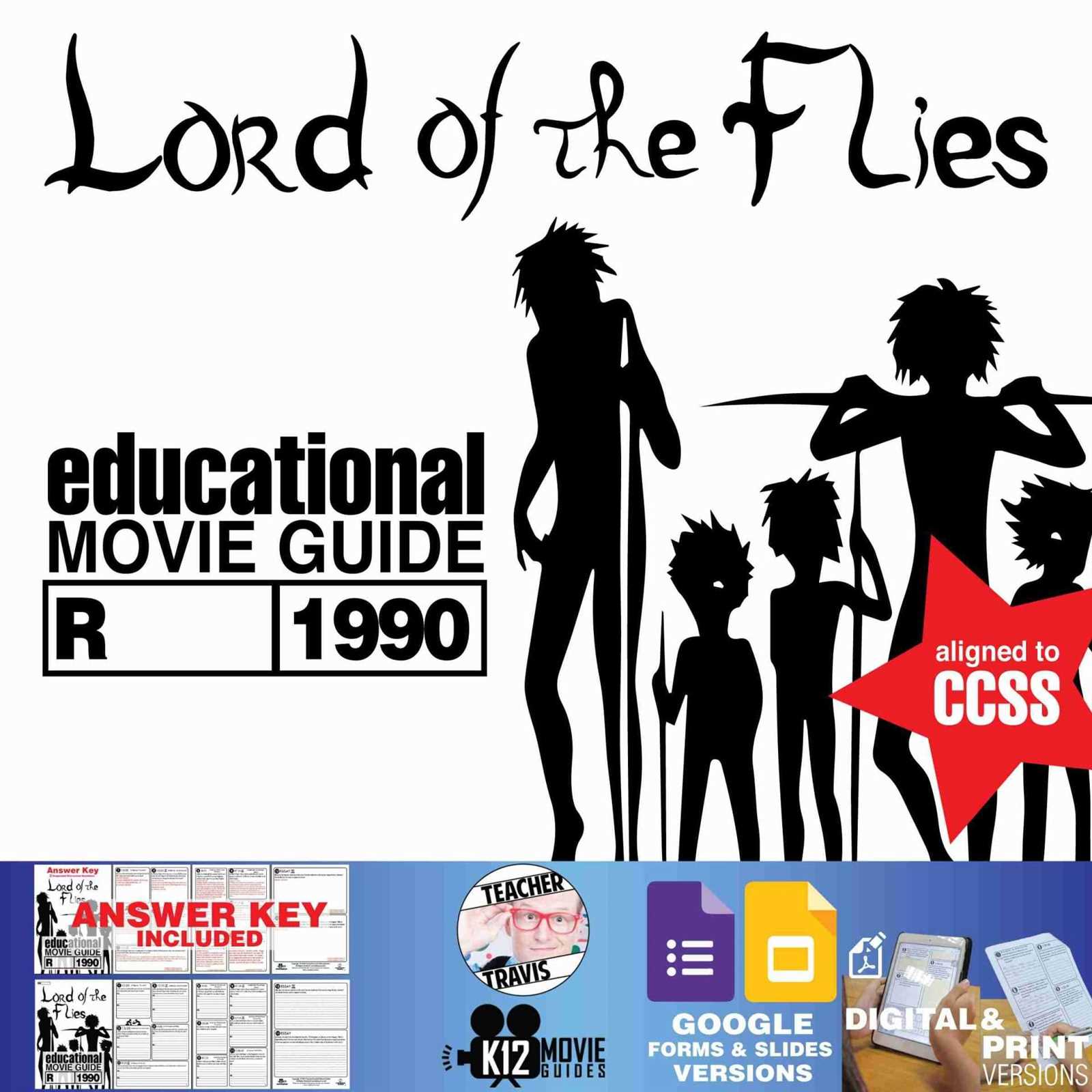
At the start of their time on the island, the boys are unaware of what dangers they might face. The notion of a mysterious “beast” becomes a symbol of their deep-rooted fear of the unknown. This fear is magnified by the isolation and the absence of adults. Some boys, particularly Ralph and Piggy, attempt to rationalize the situation, but fear drives others to abandon logic:
- The idea of the beast takes on a life of its own, with each boy’s fear feeding into a collective panic.
- Jack uses this fear to manipulate the boys, convincing them that he and his tribe can offer protection in exchange for loyalty.
- Simon, who understands the true nature of the beast, becomes an outcast, his insights ignored due to the overpowering fear that clouds everyone’s judgment.
As fear spreads, the boys’ decisions become more erratic, with many acting on instinct rather than reason. This fear leads to the sacrifice of rational thought and fuels the descent into savagery.
Fear of Losing Control
Another powerful force driving decisions is the fear of losing authority and control. Ralph, who holds the position of leadership, is constantly aware of the fragile nature of his power. As Jack’s tribe grows stronger and more chaotic, Ralph’s fear of losing his position becomes a major source of internal conflict. His desire to maintain order becomes increasingly futile as fear drives others to follow Jack’s more primal leadership:
- Ralph’s decisions become influenced by his need to keep the group together, even as his authority weakens.
- Jack’s rise to power is propelled by his ability to instill fear in others, particularly through promises of safety from the imagined beast.
- Both Ralph and Jack’s actions reflect how fear of losing control can lead to irrational choices, pushing them further from their original intentions.
Ultimately, fear becomes a tool of manipulation, with some characters using it to maintain power, while others are driven to make reckless decisions in an attempt to regain a sense of security. The story illustrates how fear can undermine reason, leading to disastrous outcomes and the erosion of moral structures.
The Concept of Moral Corruption
As the story unfolds, the gradual degradation of the boys’ moral compass becomes a central theme. What begins as a struggle for survival in an isolated environment soon transforms into a deeper conflict, one that questions the very nature of good and evil. The absence of societal rules and adult supervision leads to the boys’ descent into actions that defy the ethical standards they once knew. This transformation highlights how external circumstances can push individuals toward moral corruption, ultimately causing them to abandon their previous values and embrace chaos.
Initial Struggle Between Order and Chaos
At the beginning, the boys attempt to establish a sense of order by creating rules and a system of leadership. Ralph represents reason and civilization, hoping to maintain structure and fairness. However, as tensions rise, the boys’ desires shift from cooperation to dominance, marking the beginning of their moral decline:
- Ralph’s efforts to maintain civility and reason are undermined by Jack, who appeals to baser instincts like power and fear.
- The boys’ growing fascination with hunting, led by Jack, gradually replaces their initial concerns with survival and cooperation.
- At this stage, the desire for excitement and freedom begins to erode the boys’ sense of responsibility.
This shift from order to chaos represents the beginning of moral corruption, where the pursuit of personal gain and unchecked impulses take precedence over collective well-being.
Full Transformation into Savagery
As the story progresses, the breakdown of societal rules accelerates. Fear and desire for control become the primary motivators, with moral boundaries becoming more and more blurred. The boys, who initially tried to uphold the values of civilization, eventually embrace brutality as a means of survival and power:
- Jack’s tribe, once a group focused on protection, becomes consumed by violence and dominance, resorting to senseless killing.
- The murder of Simon, an innocent figure, is a pivotal moment that symbolizes the boys’ complete loss of morality.
- By the end, even Ralph, the symbol of order, finds himself driven by fear and a willingness to abandon his earlier ideals to escape Jack’s violent rule.
The boys’ complete moral collapse shows the devastating effects of living in an environment without the constraints of society, where corruption takes root and spreads unchecked. What was once a group of well-intentioned children becomes a savage, bloodthirsty mob, illustrating the fragility of moral integrity in the absence of structure.
The Evolution of Ralph’s Leadership
Throughout the course of the narrative, Ralph’s approach to leadership undergoes a significant transformation. Initially chosen as the leader due to his charisma and vision for a structured society, he starts with a clear sense of responsibility and a belief in cooperation. However, as challenges mount and tensions rise, Ralph’s leadership style begins to evolve, reflecting his growing awareness of the complexities of maintaining order in a chaotic environment. This shift highlights the struggles inherent in leadership, particularly when facing adversity and moral challenges.
At first, Ralph strives to create a sense of civility and organization, using his position to guide the group towards goals such as building shelters and maintaining a signal fire. His leadership is based on reason, and he believes that the boys’ collective efforts will allow them to be rescued. He values democracy, encouraging everyone to have a say in important decisions, and works hard to maintain a sense of optimism:
- Ralph’s focus on the signal fire symbolizes his dedication to hope and the possibility of returning to civilization.
- His appeal to order and rationality is evident in his attempts to establish rules and maintain the group’s cooperation.
However, as the story progresses, Ralph’s leadership becomes increasingly challenged by external pressures, especially the growing influence of Jack, whose leadership is based on fear and the promise of freedom through savagery. This conflict forces Ralph to confront the limitations of his own approach, as his idealistic vision begins to clash with the boys’ desire for power and excitement:
- Ralph’s attempts to maintain control over the group start to falter as Jack’s tribe becomes more appealing with their focus on hunting and the abandonment of rules.
- His frustration and isolation grow as he witnesses the disintegration of order and the boys’ descent into chaos.
By the end of the narrative, Ralph’s leadership has transformed from an attempt to instill rationality and hope into a more desperate and resigned role. Facing a breakdown in social structure and the rise of violence, Ralph is forced to acknowledge that his vision for society is fragile and vulnerable in the face of primal instincts. His leadership, though rooted in moral integrity, proves insufficient to maintain control in a world increasingly defined by savagery:
- Ralph’s leadership becomes more reactive, as he struggles to hold onto whatever semblance of order remains.
- The challenges of survival and the violent actions of the boys lead Ralph to question the very ideals he once championed.
Ultimately, Ralph’s evolution as a leader underscores the complex nature of power and governance, especially in an environment stripped of societal norms. His journey reflects the difficulties of holding onto one’s values in the face of overwhelming adversity and the loss of control.
Understanding the Novel’s Social Commentary
The narrative offers a powerful exploration of human nature and society, using its isolated setting to critique the structures that underpin civilization. Through the experiences of the boys, the story highlights the fragility of societal norms and the ease with which order can disintegrate into chaos. The novel reflects on the tension between civilization and barbarism, shedding light on how external systems, authority, and group dynamics shape behavior, morality, and identity.
Critique of Civilized Society
At its core, the narrative exposes the limitations of structured society and challenges the notion that civilization is an inherently stabilizing force. The boys, isolated from the influence of adults and societal rules, quickly revert to primal behaviors. This regression demonstrates how thin the veneer of civilization can be, revealing the latent savagery within humanity. The tension between Ralph’s leadership, which strives to maintain order, and Jack’s descent into violence exemplifies the struggle between the desire for structure and the pull of chaos:
- Ralph’s attempts to enforce rules and rationality are undermined by the allure of Jack’s more immediate, instinctual appeal.
- The struggle for power illustrates the darker side of human nature, where the desire for control can lead to cruelty and violence.
Human Nature and Group Dynamics
The story also reflects on the way group dynamics shape individual behavior. As the boys become divided into factions, their interactions reveal the susceptibility of individuals to collective influence. Peer pressure, conformity, and the desire for belonging lead many of them to abandon their previous moral standards. The novel suggests that under certain conditions, group identity can override personal ethics, resulting in actions that would otherwise be unthinkable. This transformation is especially evident in the boys’ increasing brutality, culminating in acts of senseless violence:
- The group’s descent into savagery reflects the psychological pressures that emerge in the absence of adult supervision and moral constraints.
- The boys’ willingness to follow Jack’s lead, even when it involves violence, highlights the dangers of unchecked power and mob mentality.
Ultimately, the story serves as a social commentary on the inherent tensions in human societies. It questions whether true civilization is merely a thin façade, and whether beneath this veneer lies a more brutal, primal instinct that, when untethered, can lead to destruction and chaos. The novel challenges readers to consider the role of authority, the fragility of morality, and the consequences of abandoning social norms.
How the Plot Develops Key Ideas
The unfolding events in the story intricately explore and expand on several central themes, utilizing character actions, conflicts, and shifting dynamics to highlight essential concepts about human nature and society. As the narrative progresses, key ideas emerge and evolve, reflecting the gradual breakdown of order, the influence of fear, and the complexities of leadership. These ideas are interwoven with the characters’ experiences, offering readers a deep reflection on civilization, morality, and power.
Gradual Descent into Savagery
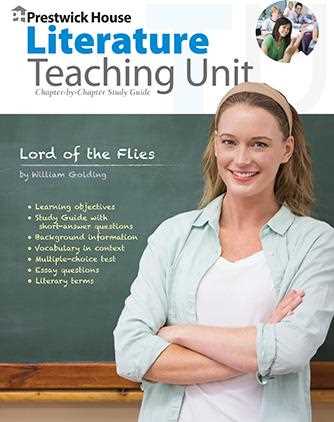
At the outset, the boys attempt to establish a sense of structure and control, striving to emulate the rules and organization they were taught in society. However, as tensions rise and their environment becomes more threatening, their grip on civility loosens. This shift is not instantaneous but occurs progressively as the boys’ individual actions reveal their inner desires for power, safety, and release from constraints. Key moments in the plot highlight this change:
- The initial attempts at governance, led by Ralph, focus on maintaining order and building shelters. These efforts gradually diminish as Jack’s hunger for dominance grows.
- The appearance of the beast symbolizes the deepening fear among the boys and the way this fear drives their choices, leading them to abandon reason in favor of primal instincts.
- Violent episodes, such as the hunting rituals and the tragic deaths, are critical turning points in the plot, signifying the complete erosion of rationality and the embrace of chaos.
Conflict and Power Struggles
The clash between Ralph and Jack serves as a central narrative device, illustrating the differing approaches to leadership and the consequences of power struggles. Through their rivalry, the story examines how authority can be challenged and how fear can be weaponized to manipulate and control others:
- Ralph’s leadership, grounded in reason and cooperation, is constantly undermined by Jack’s appeal to primal instincts and the promise of safety through violence.
- The division of the boys into two factions symbolizes the conflict between order and chaos, civilization and barbarism.
- Jack’s use of fear to manipulate the group exposes the vulnerability of individuals when confronted with uncertainty, highlighting the fragility of moral values under pressure.
Revelation of Human Nature
Throughout the plot, the boys’ journey serves as a mirror for human nature, revealing both the potential for cooperation and the dangers of unchecked aggression. As the story moves towards its climax, the actions and decisions of the characters become more extreme, leading to tragic consequences that reflect the darker aspects of humanity:
- The boys’ descent into violence and savagery ultimately forces them to confront the reality of their own impulses, showing how deeply ingrained instincts can override societal teachings when survival is at stake.
- The tragic ending underscores the destructive potential of human conflict, the inability to control innate desires, and the profound consequences of abandoning moral compasses in favor of self-interest.
In summary, the plot not only develops key ideas but also vividly portrays how human behavior is shaped by fear, power, and societal collapse. As the boys’ interactions grow increasingly complex and violent, the narrative reveals deeper truths about the nature of civilization and the fine line between order and chaos.